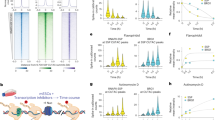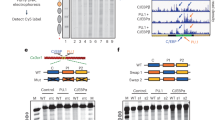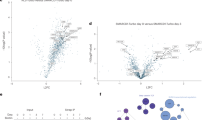Abstract
Chromatin accessibility is a hallmark of regulatory regions, entails transcription factor (TF) binding and requires nucleosomal reorganization. However, it remains unclear how dynamic this process is. In the present study, we use small-molecule inhibition of the catalytic subunit of the mouse SWI/SNF remodeler complex to show that accessibility and reduced nucleosome presence at TF-binding sites rely on persistent activity of nucleosome remodelers. Within minutes of remodeler inhibition, accessibility and TF binding decrease. Although this is irrespective of TF function, we show that the activating TF OCT4 (POU5F1) exhibits a faster response than the repressive TF REST. Accessibility, nucleosome depletion and gene expression are rapidly restored on inhibitor removal, suggesting that accessible chromatin is regenerated continuously and in a largely cell-autonomous fashion. We postulate that TF binding to chromatin and remodeler-mediated nucleosomal removal do not represent a stable situation, but instead accessible chromatin reflects an average of a dynamic process under continued renewal.
This is a preview of subscription content, access via your institution
Access options
Access Nature and 54 other Nature Portfolio journals
Get Nature+, our best-value online-access subscription
$29.99 / 30 days
cancel any time
Subscribe to this journal
Receive 12 print issues and online access
$209.00 per year
only $17.42 per issue
Buy this article
- Purchase on Springer Link
- Instant access to full article PDF
Prices may be subject to local taxes which are calculated during checkout




Similar content being viewed by others
Data availability
Next-generation sequencing data reported in this study are available at Gene Expression Omnibus, accession no. GSE158345. Source data are provided with this paper.
References
Knezetic, J. A. & Luse, D. S. The presence of nucleosomes on a DNA template prevents initiation by RNA polymerase II in vitro. Cell 45, 95–104 (1986).
Lorch, Y., LaPointe, J. W. & Kornberg, R. D. Nucleosomes inhibit the initiation of transcription but allow chain elongation with the displacement of histones. Cell 49, 203–210 (1987).
Zhu, F. et al. The interaction landscape between transcription factors and the nucleosome. Nature 562, 76–81 (2018).
Bell, O., Tiwari, V. K., Thomä, N. H. & Schübeler, D. Determinants and dynamics of genome accessibility. Nat. Rev. Genet. 12, 554–564 (2011).
Yue, F. et al. A comparative encyclopedia of DNA elements in the mouse genome. Nature 515, 355–364 (2014).
Stergachis, A. B. et al. Developmental fate and cellular maturity encoded in human regulatory DNA landscapes. Cell 154, 888–903 (2013).
Zaret, K. S. & Carroll, J. S. Pioneer transcription factors: establishing competence for gene expression. Genes Dev. 25, 2227–2241 (2011).
Bartholomew, B. Regulating the chromatin landscape: structural and mechanistic perspectives. Annu. Rev. Biochem. 83, 671–696 (2014).
Hargreaves, D. C. & Crabtree, G. R. ATP-dependent chromatin remodeling: genetics, genomics and mechanisms. Cell Res. 21, 396–420 (2011).
Clapier, C. R., Iwasa, J., Cairns, B. R. & Peterson, C. L. Mechanisms of action and regulation of ATP-dependent chromatin-remodelling complexes. Nat. Rev. Mol. Cell Biol. 18, 407–422 (2017).
Mashtalir, N. et al. Modular organization and assembly of SWI/SNF family chromatin remodeling complexes. Cell 175, 1272–1288.e20 (2018).
Hota, S. K. & Bruneau, B. G. ATP-dependent chromatin remodeling during mammalian development. Development 143, 2882–2897 (2016).
Narlikar, G. J., Sundaramoorthy, R. & Owen-Hughes, T. Mechanisms and functions of ATP-dependent chromatin-remodeling enzymes. Cell 154, 490–503 (2013).
Kadoch, C. et al. Proteomic and bioinformatic analysis of mammalian SWI/SNF complexes identifies extensive roles in human malignancy. Nat. Genet. 45, 592–601 (2013).
Ho, L. et al. esBAF facilitates pluripotency by conditioning the genome for LIF/STAT3 signalling and by regulating Polycomb function. Nat. Cell Biol. 13, 903–913 (2011).
King, H. W. & Klose, R. J. The pioneer factor OCT4 requires the chromatin remodeller BRG1 to support gene regulatory element function in mouse embryonic stem cells. eLife 6, 380 (2017).
Miller, E. L. et al. TOP2 synergizes with BAF chromatin remodeling for both resolution and formation of facultative heterochromatin. Nat. Struct. Mol. Biol. 24, 344–352 (2017).
Weber, C. M., Hafner, A., Braun, S. M. G., Kirkland, J. G., Stanton, B. Z., Boettiger, A. N. & Crabtree, G. R. mSWI/SNF promotes polycomb repression both directly and through genome-wide redistribution. Preprint at bioRxiv https://doi.org/10.1101/2020.01.29.925586 (2020).
Barisic, D., Stadler, M. B., Iurlaro, M. & Schübeler, D. Mammalian ISWI and SWI/SNF selectively mediate binding of distinct transcription factors. Nature 569, 136–140 (2019).
Papillon, J. P. N. et al. Discovery of orally active inhibitors of Brahma homolog (BRM)/SMARCA2 ATPase activity for the treatment of Brahma related gene 1 (BRG1)/SMARCA4-mutant cancers. J. Med. Chem. 61, 10155–10172 (2018).
Jagani, Z. et al. In-depth characterization and validation in BRG1-mutant lung cancers define novel catalytic inhibitors of SWI/SNF chromatin remodeling. Preprint at bioRxiv https://doi.org/10.1101/812628 (2019).
Stewart-Morgan, K. R., Petryk, N. & Groth, A. Chromatin replication and epigenetic cell memory. Nat. Cell Biol. 22, 361–371 (2020).
Zaidi, S. K. et al. Mitotic bookmarking of genes: a novel dimension to epigenetic control. Nat. Rev. Genet. 11, 583–589 (2010).
Festuccia, N., Gonzalez, I., Owens, N. & Navarro, P. Mitotic bookmarking in development and stem cells. Development 144, 3633–3645 (2017).
Ernst, J. & Kellis, M. ChromHMM: automating chromatin-state discovery and characterization. Nat. Methods 9, 215–216 (2012).
Pintacuda, G. et al. hnRNPK Recruits PCGF3/5-PRC1 to the Xist RNA B-Repeat to Establish Polycomb-Mediated Chromosomal Silencing. Mol. Cell 68, 955–969.e10 (2017).
Gaidatzis, D., Burger, L., Florescu, M. & Stadler, M. B. Analysis of intronic and exonic reads in RNA-seq data characterizes transcriptional and post-transcriptional regulation. Nat. Biotechnol. 33, 722–729 (2015).
Biggar, S. R. & Crabtree, G. R. Continuous and widespread roles for the Swi-Snf complex in transcription. EMBO J. 18, 2254–2264 (1999).
Goldberg, A. D. et al. Distinct factors control histone variant H3.3 localization at specific genomic regions. Cell 140, 678–691 (2010).
Loh, Y.-H. et al. The Oct4 and Nanog transcription network regulates pluripotency in mouse embryonic stem cells. Nat. Genet. 38, 431–440 (2006).
Chen, Z. F., Paquette, A. J. & Anderson, D. J. NRSF/REST is required in vivo for repression of multiple neuronal target genes during embryogenesis. Nat. Genet. 20, 136–142 (1998).
Kubik, S. et al. Opposing chromatin remodelers control transcription initiation frequency and start site selection. Nat. Struct. Mol. Biol. 26, 744–754 (2019).
Schick, S. et al. Acute BAF perturbation causes immediate changes in chromatin accessibility. Nat. Genet. https://doi.org/10.1038/s41588-021-00777-3 (2021).
Liu, Y. et al. Widespread mitotic bookmarking by histone marks and transcription factors in pluripotent stem cells. Cell Rep. 19, 1283–1293 (2017).
Minderjahn, J. et al. Mechanisms governing the pioneering and redistribution capabilities of the non-classical pioneer PU.1. Nat. Commun. 11, 402–416 (2020).
Hu, G. et al. Regulation of nucleosome landscape and transcription factor targeting at tissue-specific enhancers by BRG1. Genome Res. 21, 1650–1658 (2011).
Ginno, P. A. et al. A genome-scale map of DNA methylation turnover identifies site-specific dependencies of DNMT and TET activity. Nat. Commun. 11, 2680 (2020).
Cong, L. et al. Multiplex genome engineering using CRISPR/Cas systems. Science 339, 819–823 (2013).
Buenrostro, J. D., Wu, B., Chang, H. Y. & Greenleaf, W. J. ATAC-seq: a method for assaying chromatin accessibility genome-wide. Curr. Protoc. Mol. Biol. 109, 21.29.1–21.29.9 (2015).
Martin, M. Cutadapt removes adapter sequences from high-throughput sequencing reads. EMBnet. J. 17, 10 (2011).
Li, H. & Durbin, R. Fast and accurate short read alignment with Burrows–Wheeler transform. Bioinformatics 25, 1754–1760 (2009).
Gaidatzis, D., Lerch, A., Hahne, F. & Stadler, M. B. QuasR: quantification and annotation of short reads in R. Bioinformatics 31, 1130–1132 (2014).
Zhang, Y. et al. Model-based analysis of ChIP-Seq (MACS). Genome Biol. 9, R137 (2008).
McCarthy, D. J., Chen, Y. & Smyth, G. K. Differential expression analysis of multifactor RNA-Seq experiments with respect to biological variation. Nucleic Acids Res. 40, 4288–4297 (2012).
Lun, A. T. L., Chen, Y. & Smyth, G. K. It’s DE-licious: a recipe for differential expression analyses of RNA-seq experiments using quasi-likelihood methods in edgeR. Methods Mol. Biol. 1418, 391–416 (2016).
Heinz, S. et al. Simple combinations of lineage-determining transcription factors prime cis-regulatory elements required for macrophage and B cell identities. Mol. Cell 38, 576–589 (2010).
Gu, Z., Eils, R. & Schlesner, M. Complex heatmaps reveal patterns and correlations in multidimensional genomic data. Bioinformatics 32, 2847–2849 (2016).
Schoenfelder, S. et al. The pluripotent regulatory circuitry connecting promoters to their long-range interacting elements. Genome Res. 25, 582–597 (2015).
Lawrence, M., Gentleman, R. & Carey, V. rtracklayer: an R package for interfacing with genome browsers. Bioinformatics 25, 1841–1842 (2009).
Langmead, B., Trapnell, C., Pop, M. & Salzberg, S. L. Ultrafast and memory-efficient alignment of short DNA sequences to the human genome. Genome Biol. 10, R25–R10 (2009).
Lawrence, M. et al. Software for computing and annotating genomic ranges. PLoS Comput. Biol. 9, e1003118 (2013).
Domcke, S. et al. Competition between DNA methylation and transcription factors determines binding of NRF1. Nature 528, 575–579 (2015).
Chronis, C. et al. Cooperative binding of transcription factors orchestrates reprogramming. Cell 168, 442–459.e20 (2017).
Stadler, M. B. et al. DNA-binding factors shape the mouse methylome at distal regulatory regions. Nature 480, 490–495 (2011).
Tippmann, S. C. et al. Chromatin measurements reveal contributions of synthesis and decay to steady-state mRNA levels. Mol. Syst. Biol. 8, 593 (2012).
Chen, X. et al. Integration of external signaling pathways with the core transcriptional network in embryonic stem cells. Cell 133, 1106–1117 (2008).
Liu, Z. & Kraus, W. L. Catalytic-independent functions of PARP-1 determine Sox2 pioneer activity at intractable genomic loci. Mol. Cell 65, 589–603.e9 (2017).
Arnold, P. et al. Modeling of epigenome dynamics identifies transcription factors that mediate Polycomb targeting. Genome Res. 23, 60–73 (2013).
Acknowledgements
We thank L. Burger for feedback and providing lists of TF-bound sites, S. Smallwood and the functional genomics platform of the FMI for next-generation sequencing support, H. Kohler for assistance with cell sorting, and members of the Schübeler group for feedback on the project and manuscript. Research in the laboratory of D.S. is supported by the Novartis Research Foundation, the European Research Council under the European Union’s Horizon research and innovation program (grant no. 667951) and the Swiss National Sciences Foundation. M.I. was supported by a European Molecular Biology Organization long-term postdoctoral fellowship (ALTF 594-2017) and a European Molecular Biology Organization advanced fellowship (ALTF 611-2019).
Author information
Authors and Affiliations
Contributions
M.I. and D.S. conceived the study and designed the experiments. M.I. performed the experiments and analyzed the data. M.B.S. performed advanced computational analysis. F.M. contributed to ChIP–seq experiments. G.G.G. and Z.J. provided inhibitor expertise and compounds. D.S. supervised the study. M.I., M.B.S. and D.S. wrote the manuscript with input from all coauthors.
Corresponding author
Ethics declarations
Competing interests
All the authors affiliated with Novartis Institute of Biomedical Research are employees of Novartis. The remaining authors have no competing interests.
Additional information
Peer review information Nature Genetics thanks Blaine Bartholomew, Julie Lessard and the other, anonymous, reviewer(s) for their contribution to the peer review of this work.
Publisher’s note Springer Nature remains neutral with regard to jurisdictional claims in published maps and institutional affiliations.
Extended data
Extended Data Fig. 1 Chromatin accessibility changes caused by BRM014 treatment in mouse ES cells.
a. RNA levels of Brg1 (Smarca4) and Brm (Smarca2) in mouse ES cells. The proteins encoded by these genes are the primary targets inhibited by the BRM014 compound (n = 8, mean + /- sd). b. Schematic of Ino80 deletion induced by CRISPR/Cas9 system, 7-bp deletion in exon6 is highlighted in red characters. Representative western blot (repeated three times) shows cropped bands for resulting full-length Ino80 protein and loading control in WT and deleted line (uncropped blots in Source Data). c. Quantitative comparison of ATAC-seq replicates (log2 normalized counts). d. Quantitative comparison of chromatin accessibility changes (log2 fold-change) at regulatory regions upon chemical inhibition of SWI/SNF ATPase Brg1 at a concentration of 10 µM (x-axis) and 1 µM (y-axis). The effects are dose-dependent and correlated. R: Pearson’s correlation coefficient. e. Same as in d), for treatment with BRM014 at 10 µM for 24 h (x-axis) and an inactive compound at the same concentration (y-axis). Loss of accessibility is specific to the active SWI/SNF inhibitor.
Extended Data Fig. 2 Gene expression changes caused by BRM014 treatment in mouse ES cells.
a. Quantitative comparison of transcriptional changes (log2 fold-change) induced by BRM014 in different genetic background (wt on both x-axes, Ino80 KO y-axis left panel, Snf2h KO y-axis right panel). b. Quantitative comparison of transcriptional changes (log2 fold-change) induced by BRM014 in wt cells (x-axis, both panel) and changes induced by genetic deletion of Ino80 (left panel) or Snf2h (right panel).
Extended Data Fig. 3 Chromatin type and histone variant H3.3 in groups of ATAC-seq peaks.
a. Line-plots showing changes in chromatin accessibility in the different clusters upon BRM014 treatment over time measured by ATAC-seq. Each line represents a single ATAC peak from a set of 300 peaks randomly selected from each cluster, and their average is drawn as a red line. b. Percent of ATAC-seq peaks in each cluster (1 to 5) or genomic bases (genome) residing in different types of chromatin as determined by ChromHMM. c. Heatmap showing the relative enrichment of grouped ATAC-seq peaks from Fig. 2a in different types of chromatin. Enrichment values correspond to standardized residuals (observed – expected) / sqrt(V), where V is the residual cell variance calculated using the chisq.test function in R. d. Average read densities of Histone H3.3 ChIP-seq reads (top) or input chromatin (bottom) around the middle of grouped ATAC-seq peaks from Fig. 2a (1 to 5), or all ATAC-seq peaks that do not significantly change accessibility upon 24 h of BRM014 (10 µM) treatment compared to DMSO (unchanged, n = 70,450, absolute log2 fold-change < 1.0 or FDR > 0.01).
Extended Data Fig. 4 Gene-ontology enriched terms for genes differentially expressed upon SWI/SNF inhibition.
Barplots showing fold-enrichment for most enriched gene-ontology germs for differentially expressed genes upon 24 h SWI/SNF inhibition, divided into six groups based on direction (up-, down-) and dynamics (early-, middle-, late-) of response.
Extended Data Fig. 5 Enrichment of TF binding motifs in ATAC-seq peaks binned by change of accessibility upon SWI/SNF inhibition.
a. Enrichments ((observed – expected) / sqrt(expected)) and significance (-log10 of FDR) of predicted TF binding sites were calculated in ATAC-seq peaks binned (1200 peaks per bin) according to change of accessibility upon long-term (24 h) SWI/SNF inhibition. TFs with an FDR in the strongest loss bin of less than 1e-8 plus selected TFs (green squares, see below) are shown. The columns of the heatmaps correspond to bins of ATAC-seq peaks, ordered by loss of accessibility and starting on the left with the bin of strongest loss. The TFs shown in Fig. 3 (REST, OCT4/SOX2, ESRRB, CTCF and NRF1) are depicted with a green square next to their name and were included even if their FDR was larger than the selection cutoff. Motifs (heatmap rows) have been hierarchically clustered based on enrichments. b. Same as in a), but ATAC-seq peaks were binned according to change of accessibility upon short (1 h) SWI/SNF inhibition. TFs with an FDR in the strongest-loss bin of less than 1e-4 are shown.
Extended Data Fig. 6 Rapid reversal of SWI/SNF activity after short inhibition.
a. Heatmap displaying changes in chromatin accessibility compared to control cells treated with DMSO at ATAC-seq peaks upon treatment with 10 µM of compound BRM014 for increasing amounts of time and subsequent washout of the inhibitor from the growing media. Washout samples were collected 15, 30 and 60 minutes after removal of the compound. Removal of the inhibitor results in complete reversal of the accessibility landscape. Grouping and order of peaks as in Fig. 2a. b. Exemplary genomic locus showing SWI/SNF-dependent ATAC peak (dotted square) losing signal over time during treatment with BRM014 (red tracks) and total rescue of accessibility upon washout of the compound (blue tracks). c. Chromatin accessibility changes at distal REST, OCT4/SOX2, ESRRB, CTCF and NRF1 binding sites upon SWI/SNF inhibition (10, 20, 30 and 60 minutes in shades of red) and after removal of the inhibitor (15, 30 and 60 minutes in shades of blue). Upper panels: Line plots indicating changes in ATAC signal compared to DMSO control. Vertical dashed line highlights timepoint of inhibitor removal. Lower panels: Average signal over all bound sites in different conditions as above. d. Average MNase signal (fragment midpoints) at bound REST and CTCF motifs in DMSO control cells (black line), after 24 h of BRM014 treatment (red line) and after washout (blue line).
Supplementary information
Source data
Source Data Extended Data Fig. 1
Unprocessed western blot for Ino80 and lamin-loading control (shown in Extended Data Fig. 1) with overlaid marker.
Rights and permissions
About this article
Cite this article
Iurlaro, M., Stadler, M.B., Masoni, F. et al. Mammalian SWI/SNF continuously restores local accessibility to chromatin. Nat Genet 53, 279–287 (2021). https://doi.org/10.1038/s41588-020-00768-w
Received:
Accepted:
Published:
Issue Date:
DOI: https://doi.org/10.1038/s41588-020-00768-w
This article is cited by
-
Context-specific functions of chromatin remodellers in development and disease
Nature Reviews Genetics (2024)
-
The BAF chromatin remodeler synergizes with RNA polymerase II and transcription factors to evict nucleosomes
Nature Genetics (2024)
-
RNA polymerase II promotes the organization of chromatin following DNA replication
EMBO Reports (2024)
-
Energy-driven genome regulation by ATP-dependent chromatin remodellers
Nature Reviews Molecular Cell Biology (2024)
-
BCL7A and BCL7B potentiate SWI/SNF-complex-mediated chromatin accessibility to regulate gene expression and vegetative phase transition in plants
Nature Communications (2024)



